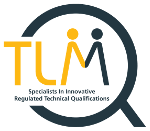Condition H - Marking
1. TLM assessors are trained and initial assessment judgements against candidate evidence screened until such time as the account manager is confident that the assessor can consistently make accurate judgements against the criteria. (Condition H1.1)
2. TLM assessment policy is for all tasks to provide credible evidence against the criteria in realistic contexts and therefore to fairly reflect competence of the candidates across a range of realistic and comparable circumstances. (Condition H1.2)
3. TLM policy is that for all qualifications in the RQF/ CQFW, assessors take account of the general level descriptors for the RQF/CQFW as well as any assessment criteria and guidance provided for specific qualifications. This is to ensure that there is consistency of difficulty across subjects as well as within subjects and that qualifications can be reliably mapped to EQF levels.
4. TLM where there are a range of different assessment tasks or methods used for determining the competence of the learner against the assessment criteria, the only requirement is that the learner demonstrates competence in keeping with the criteria, therefore if in the judgement of TLM, any specific task makes it more difficult for a learner to demonstrate their legitimate competence against the criteria, feedback will be provided to the assessor and reasonable adjustments made to ensure that the learner can demonstrate such competence that they have attained. (Condition H1.2). All assessors, moderators and verifiers must be confident that any assessment adjustments are consistently applied to ensure that the assessment criteria are secure for any particular learner and that the demand is not greater than that required for a judgement of secure against the assessment criteria. (Condition H1.3)
5. Award of credits - (This applies to assessment marked in a Centre. - (Condition H2) )
- Assessor provides learners with assessment criteria in a format that they can understand.
- Learners use self and/or peer assessment to decide their capability against the criteria (optional)
- Assessor verifies that learners match the criteria using any mandatory instruments required by TLM
- Assessor enters learner assessment data into the TLM secure on-line mark book and requests and Award
- TLM Account Manager reviews data and requests samples of learner work as appropriate (Condition H2.1, 2.2)
- TLM Account Manager checks samples against the standards and provides feedback to the Assessor (Condition H2.1, 2.2, 2.3)
- If there is a disagreement about the assessment outcomes, AM requests Assessor to review and update the assessment data using user evidence (Condition H2.1, 2.2, 2.3)
- TLM AM authorises awards for learners that meet the criteria. (Condition H2.3)
- Assessor prints awards and gives them to the learner
In the case of errors, the database entry can be removed which would cause any attempts to verify a credit certificate to fail. This is likely to be rare and learners will be given the opportunity to demonstrate that they can match the criteria to reinstate their certificate.
Each learner record on the TLM certification site has a field for a ULN. This field can be populated at the time of registering the learner or subsequently. The ULN enables TLM learner records to be transferred to other databases such as DAS, and compatibility testing has been completed with MIAP, DAS and BathData (Forvus).TLM will provide data in a format to transfer information to other legitimate databases as deemed necessary by the Regulators.
7. TLM will abide by any adjudication made by Ofqual/Qualifications Wales in relation to its qualifications in terms of specified levels of the qualification. In doing so the AO is complying with the (Condition H4)
8. TLM requires that each learner provides credible evidence against the assessment criteria to their assessor. Assessors must be confident that the learner's evidence reflects the minimum standard set by the criteria in the context of the RQF/CQFW framework or any other relevant framework to which the qualification belongs. TLM allows flexibility in the type of evidence provided based on the context and local conditions withthe aim that the evidence is produced in contexts as typical as possible of working conditions. The quantity of evidence must be sufficient for the assessor to make a secure judgment. In any case where the moderator/verifier believes the evidence to be insufficient, they will ask for more evidence taking account any evidence already received. All learners will be required to meet the same conditions in terms of providing evidence against the criteria. This then fulfils (Condition H5)
9. In cases where numeric scores are specified for evidence, those numeric scores must be a fair reflection of demonstrated competence against the assessment criteria and the rules for aggregating scores for different grades from different assessments will be made explicit and applied consistently to all learners. (Condition H5.4)
10. All results for all units and qualifications are recorded in an on-line database and these can be verified from here using the unit certificate or the qualifications certificate number. TLM's policy is to provide moderation/verification on demand with results issued within a few working days of the process. The details are provided in the TLM Policies and Procedures. The method of communicating results fits the standard RQF/CQFW structures. All results are based on the provision of sufficient and credible evidence that the learner has matched the assessment criteria. (Condition H6)

